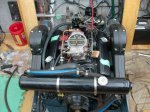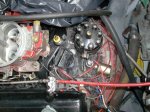Re: how to know if i need a ballast resistor
In the absence of hard data on your coil, I suggest the following: Install one. The only penalty is weaker than normal spark. If the rest of the system is wired correctly for use of a resistor, you will receive full battery voltage to the coil during cranking. When the engine starts, the voltage to the coil will reduce. If the system is not wired correctly, you'll miss the full voltage during cranking, but it will probably still start fine, if all else is well. Note that you can do your own temporary bypass by using a good cliplead between the two terminals of the resistor, shorting past it. Remove the cliplead when the engine starts.
The penalty for not using a resistor when the system is designed for one is eventual coil burnout, and/or points failure.
A resistor is cheap insurance until the details are verified.
Also note that the above posters comments about internal resistor coils and resistor wires are also quite valid, and the "voltage at points" test should give you an answer, when tested by parking the engine with the points open. Testing while operating will not give you an answer you can use for diagnosis, unless you have an oscilloscope.
Neither the internal resistor coil or resistor wire will be harmed by having an extra resistor in-circuit temporarily.
Waiting until you're sure of what you have is, of course, the safest course of action...

Chip






















